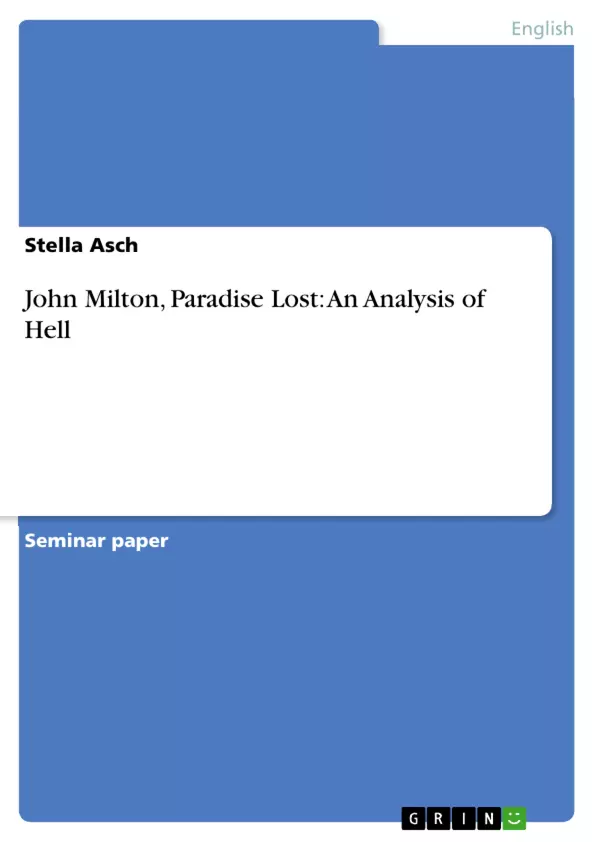This book deals with hell in Milton’s “Paradise Lost” in three respects: Hell as a place or outer state, hell as an inner state and hell as it is transferred to earth. Additionally, the introduction gives a short outline of the European concept of hell before and during the 17th century.
Table of Contents
- Introduction
- Main part
- Hell as a place / an outer state
- Placement of hell within the universe
- Description of hell
- Military / Hierarchical structure (in contrast to heaven)
- Hell as an inner state
- Hell as a place of punishment
- Feelings / Emotions in hell
- Feelings / Emotions in Satan
- Hell transferred to earth
- Hell as a place / an outer state
- Conclusion
Objectives and Key Themes
The objective of this analysis is to examine John Milton's depiction of Hell in "Paradise Lost," comparing it to the prevalent European conception of Hell before and during the 17th century. The analysis explores whether Milton's portrayal extends beyond the common understanding of his time.
- The geographical and cosmological placement of Hell within Milton's universe.
- The sensory and environmental characteristics of Hell, including its paradoxical elements.
- The contrast between Hell and Heaven in Milton's work.
- The role of Hell as a place of punishment and its psychological impact on its inhabitants.
- The potential transfer or reflection of Hell onto the Earthly realm.
Chapter Summaries
Introduction: This introductory section establishes the historical context of the concept of Hell, tracing its evolution across various cultures and highlighting its transformation throughout the centuries. It specifically addresses the European understanding of Hell during the Middle Ages and the early modern period, establishing a baseline for comparison with Milton's depiction. The introduction emphasizes the societal and cultural anxieties reflected in the concept of Hell, setting the stage for a detailed analysis of Milton's "Paradise Lost."
Main part: This section delves into a detailed analysis of Milton's depiction of Hell, exploring its physical characteristics, its inhabitants, and its symbolic meaning. This overarching chapter meticulously examines the portrayal of Hell as a physical place and as an internal state, highlighting the interplay of these aspects within Milton's work. The section uses detailed references to Milton's text to support its arguments, providing a comprehensive interpretation of the author's vision of Hell and its significance.
Paradise Lost: Hell - A Comprehensive Analysis: Frequently Asked Questions
What is the purpose of this analysis?
This analysis aims to thoroughly examine John Milton's depiction of Hell in "Paradise Lost," comparing it to prevalent European conceptions of Hell before and during the 17th century. It investigates whether Milton's portrayal transcends the common understanding of his era.
What are the key themes explored in this analysis?
The analysis explores several key themes, including the geographical and cosmological placement of Hell within Milton's universe; the sensory and environmental characteristics of Hell, including its paradoxical elements; the contrast between Hell and Heaven in Milton's work; the role of Hell as a place of punishment and its psychological impact on its inhabitants; and the potential transfer or reflection of Hell onto the earthly realm.
How is Hell depicted in this analysis?
The analysis examines Hell as both a physical location and an internal state. It investigates Hell's placement within the universe, its physical description, its hierarchical structure (compared to Heaven), its function as a place of punishment, the emotions and feelings experienced within Hell by its inhabitants, including Satan, and the possibility of Hell being reflected or transferred to Earth.
What is included in the Table of Contents?
The Table of Contents includes an Introduction, a Main part (which further breaks down into subsections examining Hell as a place/outer state and an inner state, and Hell transferred to earth), and a Conclusion.
What does the introduction cover?
The introduction establishes the historical context of the concept of Hell, tracing its evolution through various cultures and highlighting its transformation over centuries. It focuses on the European understanding of Hell during the Middle Ages and the early modern period, providing a basis for comparison with Milton's depiction and emphasizing the societal and cultural anxieties reflected in the concept of Hell.
What does the main part of the analysis cover?
The main part provides a detailed analysis of Milton's depiction of Hell, exploring its physical characteristics, inhabitants, and symbolic meaning. It meticulously examines Hell as both a physical place and an internal state, highlighting the interplay of these aspects within Milton's work and using detailed references from Milton's text to support its arguments.
What kind of information is provided in the chapter summaries?
The chapter summaries offer a concise overview of the content and focus of each section of the analysis, providing a clear understanding of the information presented in the introduction and main part of the work.
- Citar trabajo
- Stella Asch (Autor), 2003, John Milton, Paradise Lost: An Analysis of Hell, Múnich, GRIN Verlag, https://www.grin.com/document/20688



